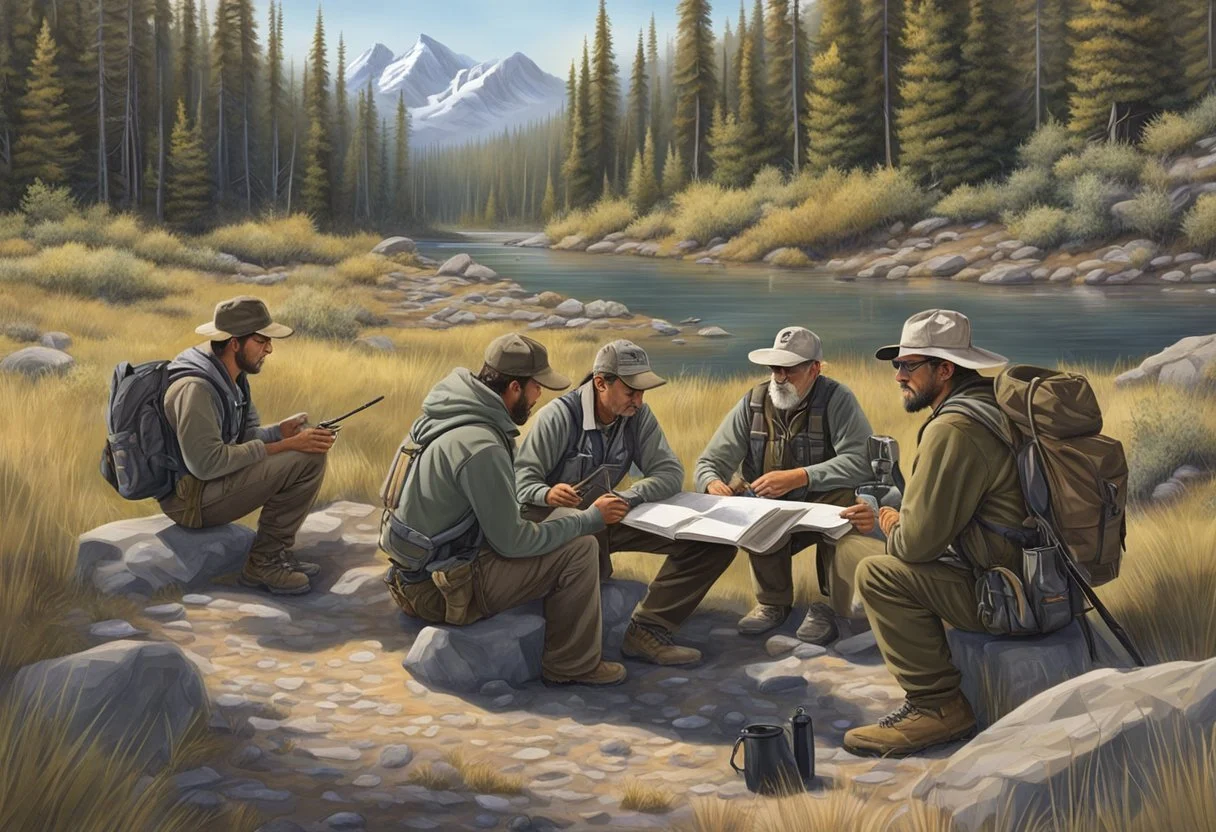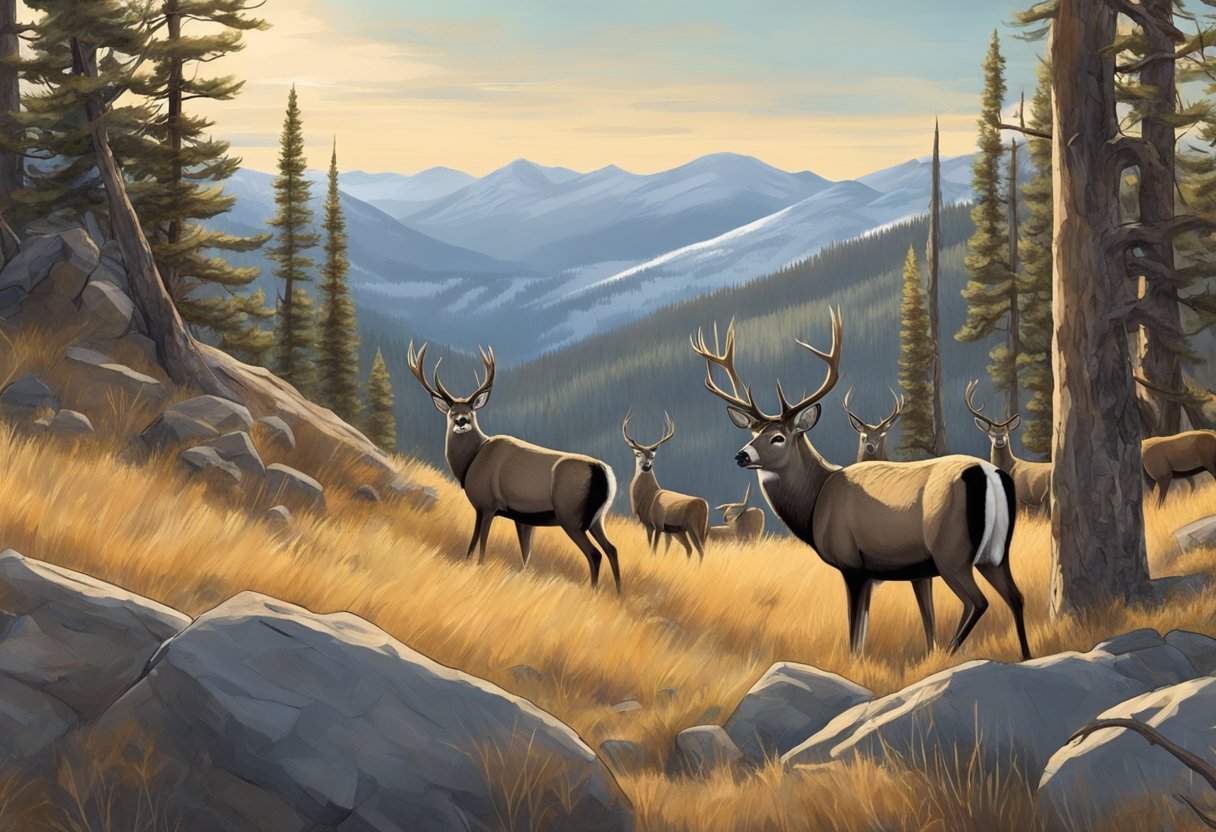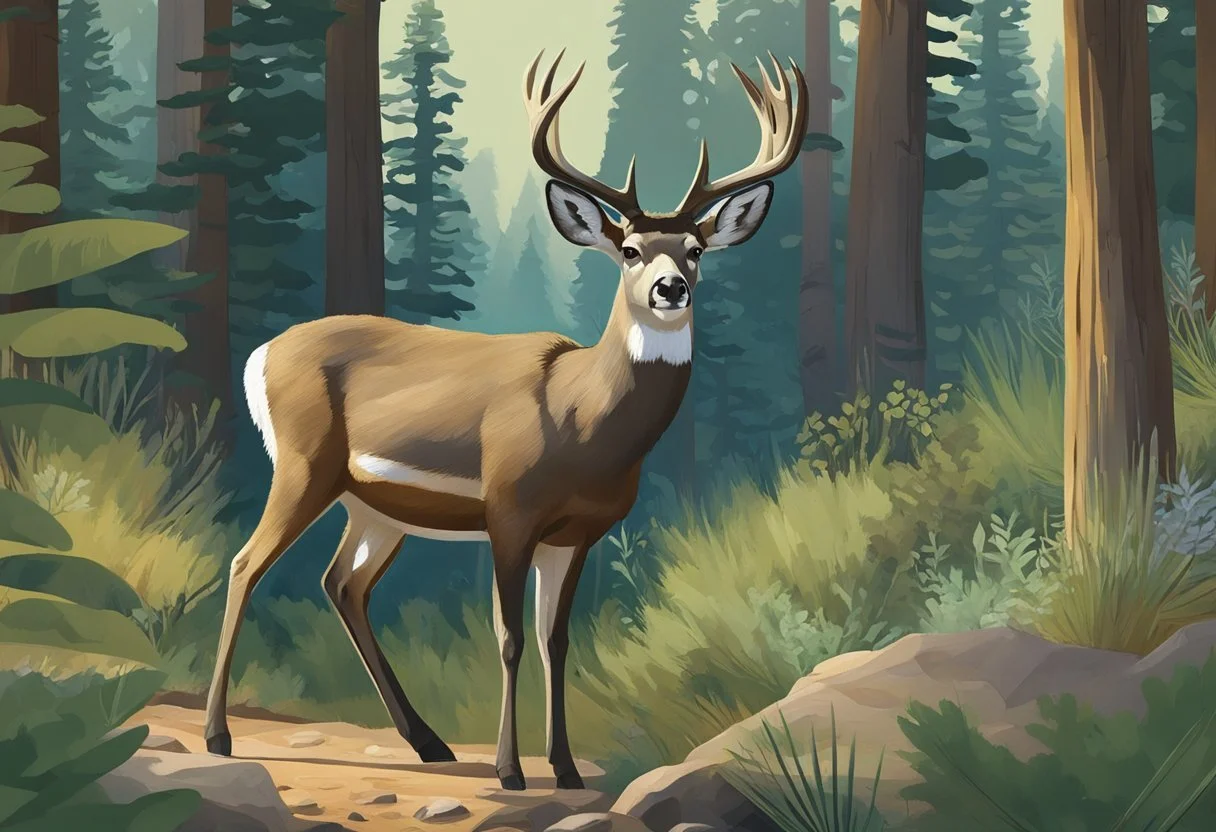Mule Deer Hunting for Beginners
Essential Tips and Techniques
Discover > Hunting for Dummies > Mule Deer Hunting for Beginners
Mule deer hunting is an exciting outdoor activity that provides beginners with a challenging yet rewarding experience. These beautiful animals, aptly named for their large, mule-like ears, inhabit various terrains across North America, from the arid deserts to the high alpine regions. For those just getting started in the world of mule deer hunting, there are important aspects to consider to ensure a successful and enjoyable experience.
First and foremost, familiarizing oneself with the habits and habitats of mule deer is crucial. Like all deer species, mule deer are crepuscular, meaning they are most active during dawn and dusk. Understanding their movement patterns allows hunters to use the limited window of opportunity effectively. By carefully studying the areas where mule deer are found, beginners can also learn how to identify signs of their presence, such as tracks, scat, and feeding areas.
It's also vital for beginners to invest in the proper hunting gear and learn how to use it efficiently. Beginners should be proficient with their chosen firearm, understand the importance of good camouflage, and have essential survival gear handy. Safety measures should be taken seriously, as hunting can quickly become dangerous without the proper precautions. With dedication to education and preparation, anyone can embark on thrilling mule deer hunts.
Understanding Mule Deer
Biology and Behavior
As big game, Mule deer are medium-sized ungulates native to North America. They get their name from their large, mule-like ears, which can grow up to 10 inches in length. The male, the Mule Deer buck, is easily distinguishable from females, known as does, by their impressive antlers. A Mule Deer buck typically grows new antlers each year, while does generally lack antlers. The antler growth stages are:
Velvet: Growth and blood supply.
Hardening: Antlers calcify, and velvet shed.
Shedding: Antlers are shed after the mating season.
Mule deer are known for their unique bounding gait, called stotting, in which all four legs leave the ground simultaneously. This allows them to quickly cross thick cover, especially when evading predators. Each hunter dreams of a trophy mule deer and the hunt for a great buck in open country.
Reproduction occurs during the fall, which is known as the rut. Mature bucks will compete with one another for the right to mate with receptive does during rut. After mating, during the rut, a doe has a gestation period of about 200 days, and gives birth to one or two fawns in the spring. Fawns are typically weaned at around three to four months of age.
Habitat and Range
Mule deer inhabit a wide range of big game habitats across North America, from coastal rainforests to arid deserts. They typically prefer areas with diverse vegetation and access to water. The different types of habitat they can be found in include:
Forests
Shrublands
Crop Fields
Grasslands
Desert edges
Mountainous regions
Throughout their range, mule deer are preyed upon by various predators, with their most common being mountain lions, coyotes, and wolves.
Subspecies Variations
There are several subspecies of mule deer, each with unique adaptations to their specific habitats. Some of the most notable subspecies include:
Rocky Mountain mule deer (Odocoileus hemionus hemionus): Directly associated with the Rocky Mountains region and the largest of the subspecies.
California mule deer (Odocoileus hemionus californicus): Found in the coastal regions of California and adapted to the mild climate.
Desert mule deer (Odocoileus hemionus eremicus): Inhabiting desert environments such as the arid regions of Arizona and Nevada.
Each subspecies displays slight physical variations in size, coloration, and antler development.
Preparation and Gear
Choosing the Right Equipment
When starting to hunt Mule Deer, selecting the appropriate gear is crucial. There are two primary options for a mule deer hunt, bow hunting and rifle hunting. Beginners should consider the following factors when choosing between a bow or rifle:
Personal preference
Legal hunting seasons for each weapon
Distance and accuracy requirements
Once you have decided on a weapon, it is essential to become proficient with its use and safety.
Clothing and Footwear
Proper clothing and footwear are vital for a successful hunt. Focus on clothing that is:
Comfortable
Durable
Weather-appropriate
Consider the following list when assembling your clothing and footwear:
Base layer (moisture-wicking material)
Insulating layer (fleece or down)
Outer layer (waterproof, windproof, or camouflage)
Footwear should be comfortable, supportive, and provide ankle protection.
Optics and Navigation
Quality optics and navigation tools can significantly enhance your mule deer hunting experience. When choosing optics, consider the following options:
Binoculars: A good pair of binoculars allows you to spot a mule deer buck from a distance, reducing the chance of scaring them away.
Rifle Scope: A high-quality scope ensures accuracy and ethical shots.
Tripod: A tripod provides stability for binoculars or spotting scopes and can prevent arm fatigue during extended glassing sessions.
A reliable navigation system is essential for safe and successful hunting. Mule deer habitats often include vast, remote landscapes that can be challenging to navigate. Consider using a GPS device, smartphone app such as OnX, or traditional map and compass to help you stay on track during your hunt.
Licensing and Regulations
Tag Acquisition and Points
Deer hunters must possess a valid hunting license and a tag specific to mule deer in order for legal hunts in most western states. State regulations in Colorado, Wyoming, Nevada, Arizona, Montana, Utah, and Idaho use a point system to allocate tags through a draw process. Points are earned by hunters who apply but don't receive a tag in a given year, and accumulating points increases the hunter's chances of drawing a tag in the future. Some states also have designated youth hunts and non-resident hunts, with specific tags allocated for those categories.
Trespassing and Permission
When planning mule deer hunts, it's important to understand the property boundaries and land ownership where you will hunt. Many western states, including Colorado, Wyoming, Nevada, Arizona, Montana, Utah, Nebraska, and Idaho, contain a mix of public and private lands, although some public land is subject to increasing hunting pressure. Hunters should always be aware of their location and ensure they have the necessary permissions to be on private land.
In some instances, landowners may allow hunters to access their property if they ask for permission in advance. Hunters can also utilize tools such as OnX Maps or state-specific mapping resources to help navigate public and private lands. Respect for landowners and their property is crucial, as good relationships between hunters and landowners contribute to the overall success and sustainability of mule deer hunting.
Scouting and Strategy
Pre-Season Scouting
Pre-season scouting is crucial to understanding the habits and patterns of mule deer. Begin by surveying the area you plan for your Mule Deer hunts. Pay attention to:
Deer trails
Bedding areas
Food sources
Using trail cameras is a great way to gather information about mule deer movements and habits. Place them near these high-traffic areas and analyze the photos to identify shooter bucks and trophy mule deer and their routines for the hunt.
Glassing Techniques
Glassing, or using binoculars and spotting scopes to locate game, is an essential skill in mule deer hunts. Follow these tips for effective glassing:
Choose the right equipment: Use good optics with suitable magnification (10x binoculars and 20-60x spotting scopes).
Glass during low-light periods: Mule deer are most active during early morning and late afternoon, so glassing during these times increases your chances of success.
Elevate your position: Glass from a vantage point that offers an expansive view of the terrain, allowing you to cover more ground.
Thoroughly scan: Start by making a quick overall scan, then methodically examine smaller areas in greater detail. Look for telltale signs like parts of a deer, such as antlers or a white rump patch.
Keep your optics steady: Use a tripod or rest your elbows on a solid surface to minimize shaking and ensure clear visibility.
Spot-and-Stalk Basics
Spot-and-stalk hunting is a popular and effective method for pursuing mule deer. To master this technique, follow these steps:
Locate your target: Using your glassing skills, identify a mule deer you want to pursue. Take note of its behavior and surroundings.
Plan your stalk: Determine a route to approach the deer while taking advantage of natural cover and avoiding detection.
Move quietly and patiently: Progress toward the Mule Deer slowly, using available cover to hide your movements, and be prepared to adjust your plan as circumstances change.
Observe wind direction: Use the wind to your advantage by staying downwind of the Mule Deer, ensuring your scent is not carried to the animal.
Prepare for the shot: As you near the Mule Deer, ensure your firearm or archery equipment is ready for a quick and ethical shot.
Hunting Techniques
Ambush and Stalking
Ambush and stalking are two highly effective techniques for beginners to consider when hunting Mule Deer. Ambush hunting involves selecting an ideal location where deer are likely to pass by, such as a trail or feeding area. Set up a ground blind or treestand, and wait patiently for the deer to come within range. Concealment and scent control are crucial to successful ambush hunting.
Stalking, also known as spot and stalk hunting, requires carefully observing Mule Deer from a distance and then quietly approaching them. Use binoculars or a spotting scope to locate Mule deer, then plan a route to get within shooting range while staying downwind. Be prepared for a slow and deliberate approach, as sudden movements can easily spook bucks.
Still-Hunting Tactics
Still-hunting is a strategic method that involves moving slowly and quietly through deer habitat, stopping frequently to scan the surroundings for any signs of movement. Take a few steps at a time, and listen carefully for rustling leaves or snapping twigs. During Mule Deer hunts they can detect motion easily, so make sure to blend in with the environment and be patient.
When still-hunting, consider the following tips:
Move into the wind to prevent deer from detecting your scent.
Utilize natural cover like bushes, trees, or terrain to conceal your approach.
Walk silently by placing the heel of your foot first, then rolling gently onto the toes to minimize noise.
Effective Rattling and Calls
Using rattling and calls can greatly improve your chances of attracting mule deer. Rattling emulates the sound of two big bucks fighting, which can lure other bucks to investigate the commotion. For best results, use real or synthetic antlers to create the rattling sound. Rattle early in the morning, and experiment with different durations and intensities to find what works best in your hunting area.
Here are some popular types of calls to use when hunting mule deer:
Doe bleats: Mimic the sound of a doe in distress to attract bucks and other does.
Buck grunts: Imitate buck vocalizations to provoke a territorial response from nearby Mule Deer.
Fawn distress call: Reproduce the sound of a distressed fawn to lure in protective does.
Making the Shot
Shot Placement
When bowhunting Mule Deer, proper shot placement is critical for a quick, ethical harvest. Aim for the vital organs, which are the heart and lungs, located in the chest cavity. When the deer is broadside, envision a line halfway the upwind side of the body and slightly forward of the middle point. A helpful guideline is to visualize the front leg and aim behind the shoulder where the heart and lungs are located.
For archery and crossbow hunters, angle is a crucial aspect of shot opportunity. A slightly quartering-away angle (the Mule Deer's front shoulder slightly away from you) provides the best opportunity for a clean pass-through and optimal penetration of the vitals.
Practice and Proficiency
Becoming proficient with your archery or crossbow equipment is essential for effective Mule Deer hunting. Regular practice will boost confidence and accuracy when a shot opportunity arises:
Develop a consistent shooting routine and aim for tight groupings at various distances.
Practice in various conditions and shooting positions to mimic real-life hunting scenarios.
Utilize 3D archery targets to help with shot placement and understanding deer anatomy.
Following Up After the Shot
Upon making your shot, patience and keen observation are essential. Here are some suggestions for following up after taking the shot:
Observe the deer's behavior and reaction, noting the shot placement and direction in which the Mule Deer fled.
Give the deer adequate time to expire. Waiting 30 minutes for a well-placed shot and up to a few hours for a less-than-ideal shot is recommended.
Follow the blood trail, marking the locations where blood is found to help track the Mule Deer if the trail becomes difficult to see.
If the deer is not found within a reasonable distance, consider seeking assistance from other hunters or using a trained tracking dog (where legal).
Post-Hunt Considerations
Ethical Considerations
As a responsible hunter, ethical considerations should be foremost in your mind. Always treat the animal with respect and appreciate the life taken to provide sustenance. Following the fair chase principle, give the Mule Deer a chance to escape and avoid using unsporting techniques.
Some ethics to practice include:
Making clean and accurate shots to minimize suffering
Following up on wounded Mule Deer and avoiding unrecovered game
Respecting the land, property boundaries, and fellow hunters
Environmental and Ethical Awareness
Impact of Weather on Hunting
Drought and heavy snow can significantly influence mule deer hunting. In the west and southwest, drought conditions lead to reduced availability of food and water sources, causing deer to seek out alternate locations. Stalkers must be aware of these changes to plan their hunts accordingly.
Heavy snow, on the other hand, can also have varying effects on mule deer behavior. When there's heavy snowfall, mule deer tend to move to lower elevations in search of food and shelter. Stalkers should be aware of these changes in deer movement patterns and adjust their strategies accordingly.
Conservation and Population Management
Being involved in mule deer hunting means playing an active role in conservation and population management. Frequent monitoring of deer populations is essential, ensuring responsible hunting practice and sustainable population growth. Stalkers must comply with local regulations regarding license requirements, bag limits, and hunting practices.
Some key ethical considerations include:
Respect for animals: Treat all wildlife with respect, avoiding any unnecessary harm or suffering.
Know your target: Be able to identify mule deer and differentiate them from other species.
Follow regulations: Adhere to all rules and guidelines set by local wildlife management agencies.
By maintaining a high level of environmental awareness and following ethical guidelines, beginner stalkers can contribute positively to the balance of the ecosystem and enjoy a fulfilling hunting experience.
Advanced Tips for Novices
Elevation Adaptation
Mule deer hunting for beginners can be a challenge at higher elevations. It is important for novice stalkers to gradually adapt to the elevation by spending many hours over a few days in the area before starting the hunt. Spending time acclimating will help reduce the effects of altitude sickness and on the positive side hunting pressure should be much lower.
Mule deer inhabit both timber and foothills, and their preference for elevation varies depending on the season. During early and late season, they are more likely to be found in lower elevations or foothills, while in mid-season, they can be encountered in higher elevations with dense timber. To help novice stalkers locate mule deer, keeping track of the following feeding and bedding areas is crucial:
Foothill feeding regions: During early and late season, mule deer often feed in grassy meadows, watering holes and open sagebrush flats.
Timber bedding areas: Mule deer typically bed in dense coniferous forests or stands of aspen trees that provide shelter from the wind, snow, and predators.
Transition zones: These are areas where the timberline meets the foothills and can be optimal hunting spots, as mule deer frequently move between their feeding and bedding locations.
Decoding Deer Behavior
Understanding mule deer behavior is a fundamental skill for successful hunting. Here are some key points to consider:
Feeding patterns: Mule deer are most active during early morning and you could be still hunting Mule Deer in the late evening. They tend to feed in open meadows or sagebrush flats in the early season, while in mid-season, Mule Deer may feed in higher timber areas where there is an abundance of browse.
Bedding habits: Mule deer often move to the cover of timber areas during the day to bed. Pay attention to dense coniferous forests or aspen stands, as these often provide shelter and safety from predators.
Travel routes: Look for well-traveled trails that connect feeding and bedding areas, as mule deer are more likely to use these paths.







